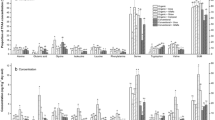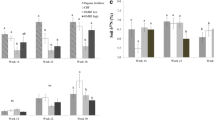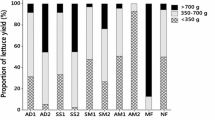Abstract
Agricultural crop production is largely dependent on inputs of mineral fertilizers. Mineral fertilizer prices are expected to rise as the competition for fossil energy increases. In order to increase the sustainability of crop production, alternatives to commercial mineral fertilizers are needed. Organic residues and fresh biomass are potentially important sources of nitrogen (N) in crop production. A study was conducted to investigate the impact of temperature on the release rate and profile of amino acids from soybean seeds (Glycine max L.) and fresh young shoots of chicory (Cichorium intybus), alfalfa (Medicago sativa) and red clover (Trifolium pratense) under anaerobic conditions. Plant material was incubated in water at either 15 °C or 35 °C, and the temporal release of total N, inorganic N, organic N and amino acids was measured during the 240 h incubation period. Amino acids and other organic N sources constituted significant proportions (20–84%) of the soluble N that was released. The contribution of organic N compounds to total N released decreased when the incubation temperature was raised from 15 °C to 35 °C, whereas the increase in temperature resulted in a higher total N release for only alfalfa and soybean. Amino acid profiles differed with plant material, incubation temperature and incubation length, with release patterns that only in a few cases could be described by first-order kinetics. Irrespective of the source, short-term liquid composting solutions will contain a low amino acid:inorganic N ratio with multiple amino acids present, which has to be taken into account when calculating the fertilizer effect. To conclude, this study reports, to our knowledge for the first time, the multiple amino acid release profiles from four different plant materials incubated under anaerobic conditions. The findings demonstrate that amino acids constitute significant proportions of the total N released and that the release patterns only for some amino acids followed first-order kinetics.
Similar content being viewed by others
References
Briddlestone A.J., Gray K.R. (1987) Production of organic fertilizers by composting, Detritus and Microbial Ecology in Aquaculture, in: Moriarty D.J.W., Pullin R.S.V. (Eds.), ICLARM Conference Proceedings 14, ICLARM, Manila, Phillipines, pp. 151–180.
Damodaran S. (1996) Amino acids, peptides and proteins, Food Chemistry, in: Fennema O.R. (Ed.), Marcel Dekker, Inc, New York, NY, pp. 385–398.
DeNeve S., Pannier J., Hofman G. (1996) Temperature effects on C- and N-mineralization from vegetable crop residues, Plant Soil 181, 25–30.
El-Naggar A.H., El-Araby A., de Neergaard A., Høgh-Jensen H. (2008) Crop responses to foliar application of organic and inorganic nitrogen, Nutr. Cycl. Agroecosys. 80, 49–60.
El-Naggar A.H., de Neergaard A., El-Araby A., Høgh-Jensen H. (2009) Simultaneous uptake of multiple amino acids by wheat, J. Plant Nutr. 32, 725–740.
Esbensen K. (2001) Multivariate data analysis in practice, CAMO Press, Oslo, Norway.
Ezeroye (2000) Solid waste management in the tropics — a case study of the Nigerian urban environment, Int. J. Environ. Stud. 57, 437–442.
Fox R.H., Myers R.J.K., Vallis I. (1990) The nitrogen mineralization rate of legume residues in soil as influenced by their polyphenol, lignin and nitrogen contents, Plant Soil 129, 251–259.
Gramss G., Voigt K.D., Bergmann H. (2003) Irrigation with plant extracts in ecofarming increases biomass production and mineral and organic nitrogen content of plants, J. Plant Nutr. Soil Sci. 166, 612–620.
Hadas A., Rosenberg R. (1992) Guano as a nitrogen source for fertigation in organic farming, Fert. Res. 31, 209–214.
Handayanto E., Giller K.E., Cadisch G. (1997) Nitrogen mineralization from mixtures of legume tree prunings of different quality and recovery of nitrogen by maize, Soil Biol. Biochem. 29, 1417–1426.
Hasegawa N., Fukumoto Y., Minoda M., Plikomol A., Kubo M. (2002) Promotion of plant and root growth by soybean meal degradation products, Biotechnol. Lett. 24, 1483–1486.
Hendersen J.W, Ricker R.D., Bidlingmeyer B.A., Woodward C. (2000) Rapid, accurate and reproducible analysis of amino acids, Agilent technologies technical reports, USA, Publication number: 5980-1193EN.
IAASTD (2009) Agriculture at a Crossroads, The Global Report, Island Press, Washington.
Jones D.L. (1999) Amino acid biodegradation and its potential effects on organic nitrogen capture by plants, Soil Biol. Biochem. 31, 613–622.
Jones D.L., Darrah P.R. (1994) Amino-acid influx at the soil-root interface of Zea mays L. and its implications in the rhizosphere, Plant Soil 163, 1–12.
Jones B.A., Hatfield R.D., Muck R.E. (1995a) Characterization of proteolysis in alfalfa and red clover, Crop Sci. 35, 537–541.
Jones B.A., Hatfield R.D., Muck R.E. (1995b) Screening legumes forages for soluble phenols, polyphenols oxidase and extract browning, J. Sci. Food Agr. 67, 109–112.
Jones B.A., Muck R.E., Hatfield R.D. (1995c) Red clover extracts inhibit legume proteolysis, J. Sci. Food Agr. 67, 329–333.
Lipson D., Näsholm T. (2001) The unexpected versatility of plants: organic nitrogen use and availability in terrestrial ecosystems, Oecologia 128, 305–316.
Magid J., Henriksen O., Thorup-Kristensen K., Müller T. (2004) Disproportionately high N-mineralisation rates from green manures at low temperatures — implications for modelling and management in cool temperate agro-ecosystems, Plant Soil 228, 73–82.
Mengel K. (1996) Turnover of organic nitrogen in soils and its availability to crops, Plant Soil 181, 83–93.
Müller T., Magid J., Jensen L.S., Nielsen N.E. (2003) Decomposition of plant residues of different quality in soil—DAISY model calibration and simulation based on experimental data, Ecol. Model. 166, 3–18.
Onduru D.D., Diop J.M., Van der Werf E., De Jager A. (2002) Participatory on-farm comparative assessment of organic and conventional farmers’ practice in Kenya, Biol. Agric. Hortic. 19, 295–314.
Owen A.G., Jones D.L. (2001) Competition for amino acids between wheat roots and rhizosphere microorganisms and the role of amino acids in plant N acquisition, Soil Biol. Biochem. 33, 651–657.
Palm C.A., Gachengo C.N., Delve R.J., Cadisch G., Giller K.E. (2001) Organic inputs for soil fertility management in tropical agroecosystems: application of an organic resource database, Agr. Ecosys. Environ. 83, 27–42.
Papadopoulos Y.A., McKersie B.D. (1983) A comparison of protein-degradation during wilting and ensiling of 6 forage species, Can. J. Plant Sci. 63, 903–912.
Persson J., Näsholm T. (2001) Amino acid uptake: a widespread ability among boreal forest plants, Ecol. Lett. 4, 434–438.
Persson J., Näsholm T. (2002) Regulation of amino acid uptake in conifers by exogenous and endogenous nitrogen, Planta 215, 639–644.
Ruffo M.R., Bollero G.A. (2003) Residue decomposition and prediction of carbon and nitrogen release rates based on biochemical fractions using principal-component regression, Agron. J. 95, 1034–1040.
SAS Institute Inc. (2004) SAS/STAT Software. SAS Institute Inc., Cary, NC.
Sato N., Quitain A.T., Kang K., Daimon H., Fuijie K. (2004) Reaction kinetics of amino acid decomposition in high-temperature and high-pressure water, Ind. Eng. Chem. Res. 43, 3217–3222.
Sechtig A. (1992) Nitrate/nitrite, nitrite in 2% acetic acid plant extracts, QuikChem Method 13-107-04-1-A, Lachat Instruments, Milwaukee, WI.
Smil V. (1999) Nitrogen in crop production: an account of global flows, Global Biogeochem. Cy. 13, 647–662.
Sullivan M.L., Thoma S.L. (2004) Cloning and characterization of red clover polyphenol oxidase cDNAs and expression of active protein in Escherichia coli and transgenic alfalfa(1 [w]), Plant Physiol. 136, 3234–3244.
Switala K. (1993) Ammonia (salicylate) in 2 M KCl soil extracts, QuikChem method 12-107-06-2-A, Lachat Instruments, Milwaukee, WI.
Tilman D., Cassman K.G., Matson P.A., Naylor R., Polasky S. (2002) Agricultural sustainability and intensive production practices, Nature 418, 671–677.
Thornton B., Robinson D. (2005) Uptake and assimilation of nitrogen from solutions containing multiple N sources, Plant Cell Environ. 28, 813–821.
Verma L., Martin J.P., Haider K. (1975) Decomposition of C-14-labeled proteins, peptides, and amino acids and complexed with humic polymers, Soil Sci. Soc. Am. J. 39, 279–284
Weigelt A., Bol R., Bardgett R.D. (2005) Preferential uptake of soil nitrogen forms by grassland plant species, Oecologia 142, 627–635.
Author information
Authors and Affiliations
Corresponding author
About this article
Cite this article
El-Naggar, A., Rasmussen, J., de Neergaard, A. et al. Effect of plant species and temperature on amino acid release from plant material. Agron. Sustain. Dev. 30, 679–688 (2010). https://doi.org/10.1051/agro/2009049
Accepted:
Issue Date:
DOI: https://doi.org/10.1051/agro/2009049




